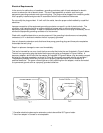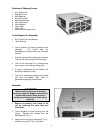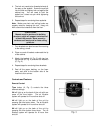
3
WARNING
1. FOR YOUR OWN SAFETY, READ
INSTRUCTION MANUAL BEFORE
OPERATING THE TOOL. Learn the tool’s
application and limitations as well as the
specific hazards peculiar to it.
2. KEEP GUARDS IN PLACE and in working
order.
3. ALWAYS WEAR EYE PROTECTION.
4. GROUND ALL TOOLS. If tool is equipped
with three prong plug, it should be plugged
into a three-hole electrical receptacle. If an
adapter is used to accommodate a two
prong receptacle, the adapter lug must be
attached to a known ground. Never remove
the third prong.
5. KEEP WORK AREA CLEAN. Cluttered
areas and benches invite accidents.
6. DON’T USE IN DANGEROUS
ENVIRONMENT. Don’t use power tools in
damp or wet locations, or expose them to
rain. Keep work area well-lighted.
7. KEEP CHILDREN AND VISITORS AWAY.
All children and visitors should be kept a
safe distance from work area.
8. MAKE WORKSHOP CHILDPROOF. Use
padlocks, master switches, or remove
starter keys.
9. DON’T FORCE TOOL. It will do the job
better and be safer at the rate for which it
was designed.
10. USE RIGHT TOOL. Don’t force tool or
attachment to do a job for which it was not
designed.
11. WEAR PROPER APPAREL. No loose
clothing, gloves, neckties, rings, bracelets,
or other jewelry to get caught in moving
parts. Nonslip footwear is recommended.
Wear protective hair covering to contain long
hair.
12. ALWAYS USE SAFETY GLASSES. Wear
safety glasses (must comply with ANSI
Z87.1). Everyday eyeglasses only have
impact resistant lenses; they are not safety
glasses. Also use face or dust mask if
cutting operation is dusty.
13. SECURE WORK. Use clamps or a vise to
hold work when practical. It’s safer than
using your hands and frees both hands to
operate tool.
14. DON’T OVERREACH. Keep proper footing
and balance at all times.
15. MAINTAIN TOOLS IN TOP CONDITION.
Keep tools sharp and clean for best and
safest performance. Follow instructions for
lubricating and changing accessories.
16. DISCONNECT TOOLS before servicing
and when filters.
17. USE RECOMMENDED ACCESSORIES.
The use of accessories and attachments not
recommended by manufacturer may cause
hazards or risk of injury to persons.
18. AVOID ACCIDENTAL STARTING. Make
sure switch is in “OFF” position before
plugging in power cord.
19. NEVER STAND ON TOOL. Serious injury
could occur if the tool is tipped or if the fan
blade is accidentally contacted.
20. CHECK DAMAGED PARTS. Before further
use of the tool, a guard or other part that is
damaged should be carefully checked to
ensure that it will operate properly and
perform its intended function-check for
alignment of moving parts, binding of
moving parts, breakage of parts, mounting,
and any other conditions that may affect its
operation. A guard or other part that is
damaged should be properly repaired or
replaced.
21. NEVER LEAVE TOOL RUNNING
UNATTENDED. TURN POWER OFF.
Don’t leave tool until it comes to a complete
stop.
22. DRUGS, ALCOHOL, MEDICATION. Do not
operate tool while under the influence of
drugs, alcohol or any medication.
23. MAKE SURE TOOL IS DICONNECTED
FROM POWER SUPPLY while motor is
being mounted, connected or reconnected.
24. WARNING: Some dust created by power
sanding, sawing, grinding, drilling and other
construction activities contains chemicals
known to cause cancer, birth defects or
other reproductive harm. Some examples of
these chemicals are:
• Lead from lead based paint
• crystalline silica from bricks and cement
and other masonry products, and
• arsenic and chromium from chemically-
treated lumber.
25. Your risk from those exposures varies,
depending on how often you do this type of
work. To reduce your exposure to these
chemicals: work in a well ventilated area,
and work with approved safety equipment,
such as those dust masks that are
specifically designed to filter out microscopic
particles












